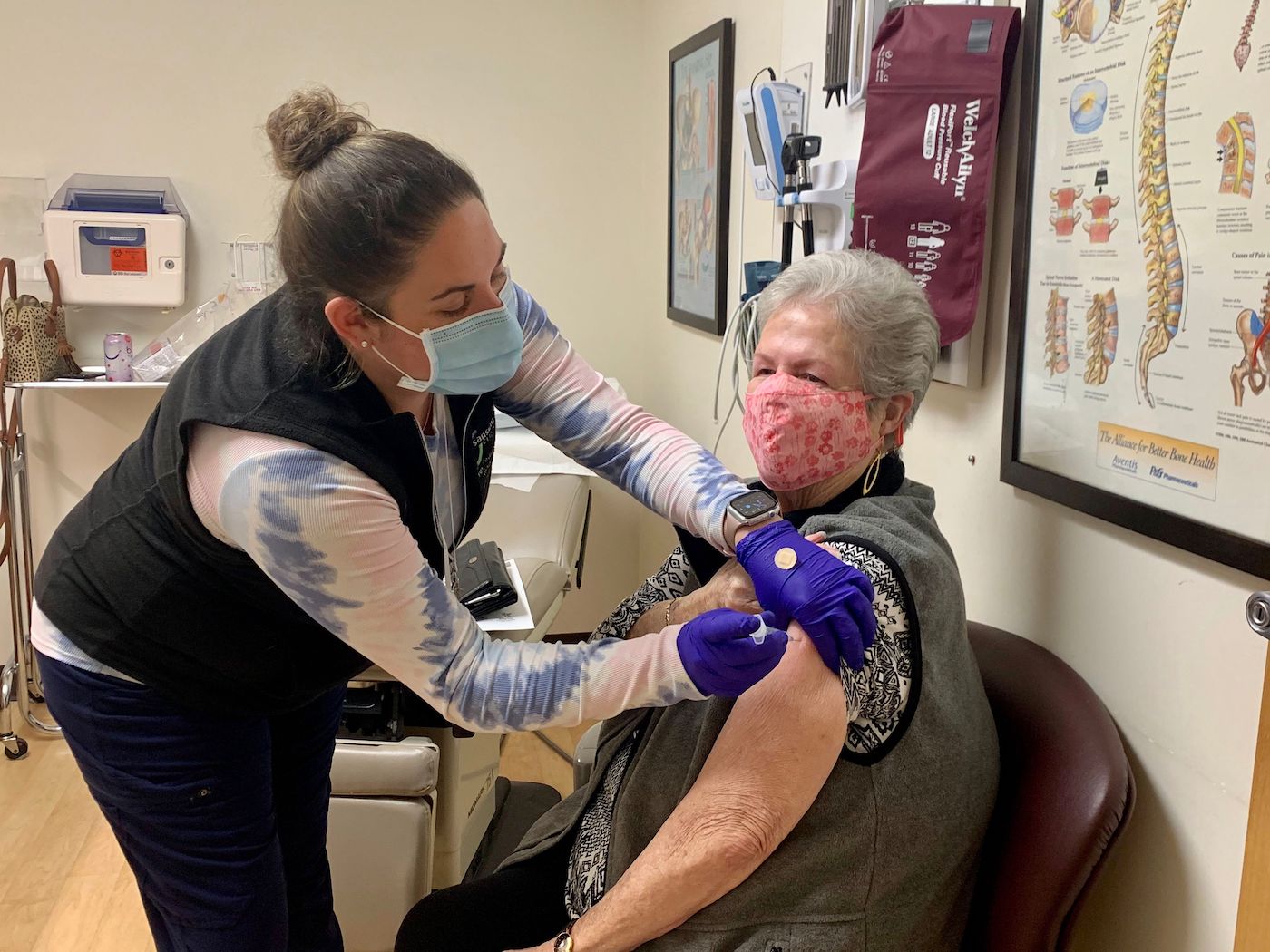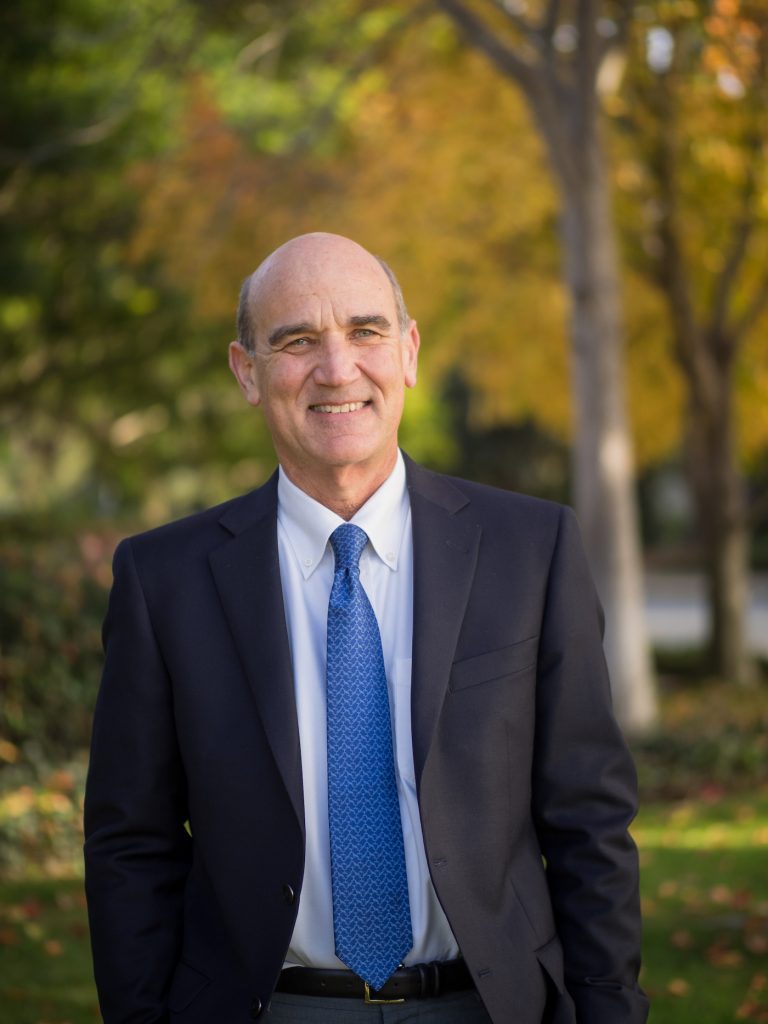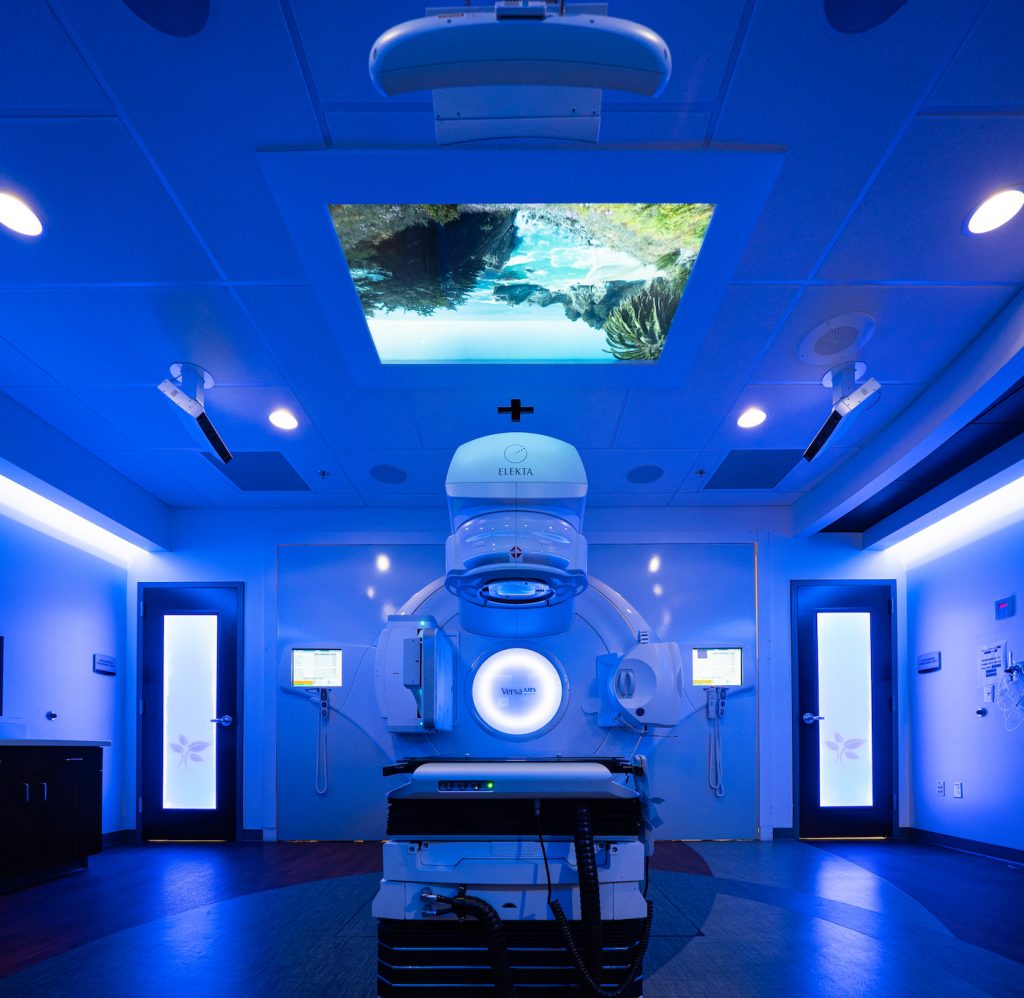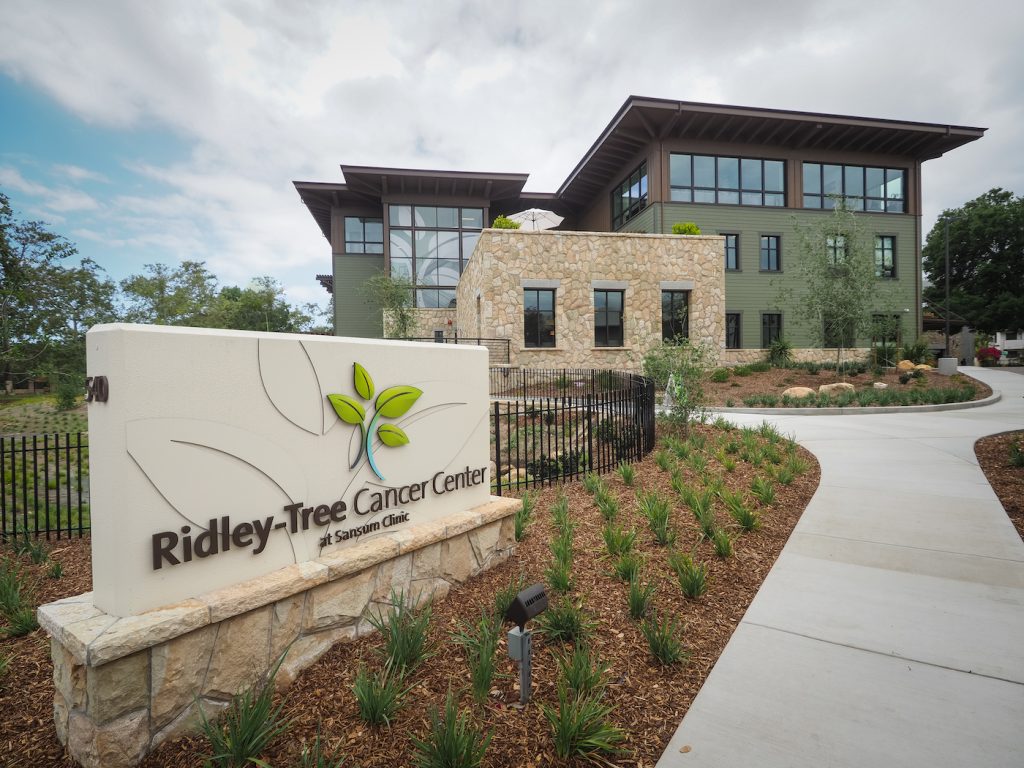Mayo of the West? Sansum President Explains Why Santa Barbara is on the Cutting Edge of Medicine

When my husband and I moved our family from Los Angeles to Santa Barbara in search of a more congenial habitat, we were determined to hold on to one key big city perk — excellent medical care. So, we kept our L.A. doctors despite the time we knew it meant we’d spend in the car.
Unfortunately, hours in traffic turned into dreaded lost days and ultimately the putting off of important check-ups, dental appointments, etc. As it became clear that living in Montecito was not just a fleeting fancy, but the place we would call home, we began our search for local doctors — though we still worried that we’d have to compromise on quality, despite the fact that over the years I’d hear stories about the world class doctors at Sansum Clinic and Cottage Hospital — stories about lives saved, diseases successfully treated, and great outcomes from surgeries.
Then COVID hit, and from my vantage point at this newspaper I got a front row seat to the reality that despite the mixed messaging coming out of the Federal and State governments on how to deal with the pandemic, Sansum and Cottage seemed laser focused as they worked to pull our community through our unprecedented coronavirus nightmare – first by treating those infected with COVID (at great personal risk), and then by working vigilantly to vaccinate any and all willing residents as each group became eligible for the vaccine.
World-Class Care in our Backyard

“The Mayo of the West” is a term I’ve heard to describe the one-two punch of Cottage Hospital and Sansum Clinic, most recently from Santa Barbara’s former mayor Hal Conklin in a conversation I wrote about a few weeks back. Recently treated for a serious condition that required brain surgery and a great deal of subsequent aftercare, Conklin spoke from personal experience when he strongly recommended Santa Barbara continue to invest heavily in its world-class medical resources.
My husband’s parents recently relocated here from New York City for some medical rehabilitation. My father-in-law, Dr. Stephen Firestein, has been a doctor in New York City for 60-plus years, serving on the faculty of the Medical School at Columbia University. His father before him was a doctor, as was my mother-in-law’s father. One of the things my in-laws always enjoyed about New York was that they believed they would always get “the best” medical care available. Then they got here, and it turns out they both had a raft of issues that had been undiscovered and hence untreated by their experts in New York. Dr. Firestein insists that across the board the level of medical care and expertise he has experienced here, in what he describes as “a boutique medical experience” with his various medical specialists in Santa Barbara, has been superior to any care he ever received in New York City.
I wanted to more deeply understand the medical landscape of Santa Barbara, as well as the culture of our healthcare professionals, and was encouraged by Montecito resident and Sansum Clinic Public Trustee Vicki Hazard to spend some time with Sansum’s president and highly regarded physician, Kurt Ransohoff. Along with Sansum’s public information officer Jill Fonte, Dr. Ransohoff offered me a guided tour of Sansum Clinic, and I took them up on their offer.
This interview is a result of the time we spent together and just the beginning of us sharing with our readers what’s happening in the healthcare realm right in our backyard.
Gwyn Lurie: Is it unusual for a community of this size to have this level of healthcare?
Kurt Ransohoff: To have the quality of healthcare that a community of this size has is really unusual. It’s just not that many other places that are this size that have the array of services and the sophistication of the medical care. And it’s not just Sansum. It’s Cottage, and it’s other doctors in this community. It’s the whole compilation of stuff.
GL: You’ve been the medical director of Sansum since ‘97, and the president since 1998, so you’ve seen a lot of change over the years in Santa Barbara, I would imagine.
KR: I think that there’s been really significant change in the healthcare industry in the last 25 years. Some of it is just an understanding of science that has allowed for the technological advances that we’ve seen. The vaccine is a perfect example. Twenty-five years ago, if you had said to somebody, “A new illness will come out, and we’ll invent an mRNA vaccine,” people would just say that’s impossible. You can’t even remotely do that. So, in that sense, any place that’s a current provider and is hiring up-to-date people is going to experience big change just over that period of time.
GL: But Santa Barbara has changed, right? It seems to me that there was a time that most people would never stay here for important procedures and now people are going through cancer from soup to nuts right here in Santa Barbara and heart disease and other major illnesses. So, to what do you attribute those leaps and bounds?
KR: I think there’s been a big investment by this community in the healthcare here. If you think about what we raised from the community for Ridley-Tree Cancer Center, and what was raised by the community for the new hospital, this community has indicated that it wants high quality healthcare here, and that it wants things that can be done here to be done here. I think that providers at Sansum, Cottage, and the independent doctors have all responded to that.
Also, just over time, and this is now a big picture thing like the mRNA vaccines, so many highly trained specialists are generated by institutions over the last 25 years that there are just more super smart people out there. It was funny. I don’t know if you’re familiar with Mohs surgery.
GL: For skin cancer?
KR: Yes. When I got here, there was maybe one or two docs in town that did it. And I’m not sure anybody had done a fellowship in it. Now there’s probably six or seven people who do it in town… I think that the investment in the community and again, just the whole level of expertise that’s out there… I mean just to brag for a moment, we’ve gone out of our way to bring people in who are the first of their kind in this community. The first board-certified Oncological surgeon we’ve just brought in, for example, he’s capable of doing operations that just couldn’t be done here before… We have surgeons that go through the six or seven years of training, and they do a couple of extra years in just doing very specific, complicated cancer operations.
GL: Is it challenging to recruit the best to come to Santa Barbara? What are your obstacles?
KR: The answer is yes, it is challenging. The biggest obstacle is the cost of housing. You just have to find somebody who either really wants to be here or who was here before. A lot of times we’ll get people like “I went to UCSB, and then I went to medical school in Massachusetts, and I did my residency at Atlanta, and my fellowship in Baltimore, but I’ve always wanted to get back.”
And sometimes the size of the town can be a selling point because it’s such a great place to live; but it can also be a problem because if your spouse has a job that really requires you to be in a big city…
GL: Are the salaries you offer competitive?
KR: I’d say that we’re close. It can be a challenge because of the fact that we’re independent. So sometimes we’re just up against institutions that just have much deeper pockets… On this the community has been very helpful. We’ve received a lot of donations over the years to help elevate the level of care in the community and we are able to help with housing like most other big nonprofits in Santa Barbara do. You have to do it because it’s so hard.
GL: How do you help with housing?
KR: Many years ago, we went to Westmont and asked, “How is it that they are able to bring professors here?” They were really nice about sharing the sort of model that they had used; something called a Shared Appreciation Loan. Where we will invest in somebody’s house, and then we have an equity stake in the house. Then years later, and it can be many, many years later, we finally get paid back. Then we just recycle it for the next doctor. It’s a really great program that’s allowed us to bring a lot of doctors into the community.
GL: Can you explain to me the relationship between Sansum, Cottage, and Ridley-Tree and how they’re interconnected and work together?
KR: So, Cottage and Sansum are separate entities. But we work really closely together on community problems. Cottage has been a partner in the Shared Appreciation Loan program. So sometimes Cottage and Sansum will bring doctors in together. It’s actually interesting. That program started because of a generous donation from somebody who lives in Montecito who many, many years ago said that they wanted to make a donation that would result in Cottage and Sansum working together.
So, we’re separate, but we work very closely together. For instance, right now we’ve been talking a lot with them about if we should combine our vaccine operations. We haven’t to this point because there wasn’t enough vaccine for that to make sense, but that’s the kind of community thing that we will cooperate, work really closely with Cottage on.
GL: Is it a competitive relationship?
KR: Yes, we also are competitors in a lot of things. We are competitors and cooperators. We cooperate because we should on a lot of things, and then we are also competitors. They have an urgent care. We have an urgent care. We have outpatient surgery. They have outpatient surgery. We have radiology. They have radiology. So, it’s just the way it is. We are both nonprofits with boards that are deeply concerned about the level of care in the community.
GL: So, a member of the community gets sick. Why would you go to Sansum urgent care versus Cottage emergency room? What’s the difference?
KR: Oh, that’s a good question. So, there are times when patients will call me and I’ll say you should go to the emergency room because if I think with what you have, you’re going to wind up in the hospital anyway, you might as well just start at the emergency room. Or if I think that they truly have something that might be life-threatening. Well then, you’ll usually call the fire department, and they’ll take them to the emergency room. For other patients, when I don’t think you need to be admitted, you need some things done, maybe you should just go to our urgent care. Sometimes it can be less crowded and less frightening than going to the ER. It can be a lot less costly to go to urgent care than it would be to go to the emergency room, which is a real issue if you don’t really need an ER.
So, we’ve put the urgent care right next to the CT scanner. Ten years ago, if somebody had fallen off their bike and had a headache, they’d have to go to the hospital because they need a CAT scan. Now, if the person’s fine. They’re walking around. They’re just complaining I fell off my bike and I got a headache, but they’re okay, they really need a CAT scan, but they probably don’t need to go to the emergency room. We can get the CAT scan here, and the visit will be shorter, and it will be a lot less expensive. At the end of the day, the acuity really is the main driver.
GL: What are some other cooperative efforts?
KR: So, if somebody has an abnormal PSA let’s say, or an abnormal rectal scan, and this person needs a biopsy. Sometimes what will happen nowadays is that you’ll do an MRI of their prostate to see if it looks abnormal or not. If something looks abnormal, the problem is you can’t do a prostate biopsy inside an MRI.
So, we are able to take that MRI image and run it through computer software, and then it will show up on an ultrasound, so that when the ultrasound is looking at the prostate, the MRI image is more or less fused into the ultrasound image… So, yeah, this is a really good example. Before, everybody had to go to Los Angeles for that because we just didn’t have it. You need a 3 Tesla MRI, not a car, but “3 Tesla” are the units by which you measure the strength of the electromagnetic field. You need a 3 Tesla MRI to do a prostate MRI comfortably. We don’t have one of those, but Cottage has one. This is a good example of cooperation. Cottage does the MRI; they ship it over electronically to us. We do the ultrasound… So, you have two different institutions basically working together so a patient doesn’t have to drive to L.A. for that technology.

GL: Still, many people are under the impression that they need to travel somewhere else to get the “top person” in a certain area of medicine.
KR: Well, my dad was always of the opinion that there was only one doctor in the country for any condition that he had… I remember he had a cataract, and he is asking, “Who’s the best guy in the country?” I said “Dad, there’s no best guy in the country for that. There are dozens of people who are probably 100 miles from where you live. There’s literally dozens of people who could do it as well as anywhere else” because it was a simple thing. So, there are occasional people like that who just believe that there’s only one person wherever who can do what they need. But, for most people, they want to see somebody who’s really good and highly skilled at what they do, and they want to have it done in a facility that’s as good as anywhere. Most of the time, that can happen here in Santa Barbara either at Sansum or at Cottage, or at Sansum and Cottage together, or with the great doctors in the community. Occasionally, we as physicians will recommend that somebody needs to go out just because it’s so unusual there may really be a doctor, and maybe that person is at Cedars or MD Anderson… but those incidents are very, very rare in proportion to the times when people like my dad think there’s got to be one person somewhere where I should specifically go to.
GL: Do all of the doctors at Sansum have visiting privileges at Cottage?
KR: Yes, they all do. You know, hospital medicine has gotten so specialized now that we have a group of doctors who only do hospital work. So, they will admit those patients, but the doctor can go visit them and all of the specialists, or virtually all of the specialists, too.
I think one of the real benefits of Santa Barbara is the sharing and the cooperative nature. I mean the MRI prostate fusion thing is a good example… Cottage, Sansum, competitors, sharing the information needed to take care of the patient right here. I think that’s really true in Santa Barbara. It’s particularly true because we use EPIC, the same computer system that Cottage uses. It’s also the same computer system that UCLA uses and UC San Francisco and Stanford and Cedars; we all use the same computer systems.
“My late husband, Jack, and I saw a need for infrastructure to bring up the physical quality of the Clinic to the incredible quality of our committed doctors… I think we Santa Barbarians are so lucky to have all the medical services we need here without ever having to get on the 101. We have assembled at Sansum Clinic the most diversified, well trained, and caring group of physicians, physician assistants, nurses, and allied workers in the Central Valley. The Ridley-Tree Cancer Center has the most state-of-the-art equipment between San Francisco and Los Angeles.”
— Julie Nadel, Montecito resident and Sansum donor
GL: We are going to do a deeper dive into the various departments at Sansum, but is there anything else you’d like to say generally about Sansum?
Jill Fonte: One of the things I think is really important about Sansum is that we have doubled the number of female providers in the last 20 years, and we have some incredibly talented female surgeons and it’s just a really neat thing for people to know. We have a female colorectal surgeon…
KR: We have an ENT, an orthopedist, two general surgeons, and all the gynecologists. Two eye surgeons… there’s a lot to talk about.
GL: That’s a good story on its own: The female doctors at Sansum.
GL: Can you talk about what role Sansum has played in the COVID crisis?
KR: We’ve done a lot in the COVID arena. We were the first (in Santa Barbara) to do a mass testing operation… I think we’ve done at least 25,000 COVID tests over the last many months. It was interesting how that happened. We needed a trailer because we were going to do testing outside. So, we called MarBorg and said, “Do you have a trailer we can borrow to COVID test people?” They said, “It’ll be there in half an hour.” Which was, again, sort of emblematic of the cooperative nature of the whole community… So, the testing’s been huge.
And we provide at least half the ICU doctors… So, when somebody gets really sick, there’s at least a 50% chance that it’ll be a Sansum ICU doctor.
Then we were pretty fast into the vaccine. Cottage was great. They vaccinated their staff, but we started vaccinating the community… I think we’ve vaccinated at least around about 15,000 or 16,000 at this point. That’s dwarfed by what Cottage has done and they need real credit. The Public Health Department has done amazing in terms of volume, but we’ve been in it with them all right from the beginning.
GL: Has Sansum taken a financial hit from COVID?
KR: Yes, last April/May our revenues dropped 50% at least. We had to furlough around 500 people. It was horrible. I think we laid off one. So, everybody else was offered their job back… but a substantial number of people did not come back because their kids didn’t go to school or some other COVID-related thing intervened in their personal life. There’s nobody to take care of their kids and that kind of stuff. But we brought everybody back. In addition to continuing insurance coverage for those furloughed, we paid the premiums they would ordinarily have to pay, for those who were furloughed more than 50%. We were just trying to help them as we all weathered the storm.
GL: So, what do you guys need to help you recover?
KR: Mostly we’ve been asking for help around what we call the Pandemic Relief Fund… It’s two parts: One is that there was a lot of missing revenue and two is that there’s ongoing expenses that we’re still dealing with. For example, tonight there’s a vaccine clinic going on. So, we’re probably paying 20 people overtime, nurses and other support staff, to vaccinate. They’re not necessarily Sansum Clinic patients anymore. Just whoever signs up on the state website, and if they give their insurance information, we have a chance of billing an insurance company. If they don’t provide insurance information, they have zero chance of billing anybody for it. I don’t know, we do about 1,500 of those a week.
GL: Sansum is a not-for-profit, correct?
KR: Yes. It has been since the ‘70s.
JF: We were really early in the group model in believing that medicine is better when you specialize, and that’s still the model that we have today. So, when people call us the Mayo Clinic of the West, Kurt, don’t you think it sort of ties into that?
KR: Yeah, I think the premise upon which both organizations were founded was that if you could get doctors working together that you could provide a better outcome for patients. And that’s true today both at Sansum and at the Ridley-Tree Cancer Center.

GL: Let’s talk a little about the Ridley-Tree Cancer Center.
KR: The Ridley-Tree Cancer Center is actually part of Sansum Clinic. We branded it separately to acknowledge the incredible generosity of Leslie Ridley-Tree, and also to indicate this is the community cancer center. If you’re not a Sansum Clinic patient, it’s okay. One hundred percent you’re welcome to come. It’s really a gem on the Central Coast and in all of California. Again because of the level of expertise… Our linear accelerators that we saw on our tour with the really thick cement (for radiation oncology treatment), those are state-of-the-art machines; and then you have highly trained doctors. Then you get into, why do you need to go somewhere else for radiation?
Then we have excellent surgeons. We have some breast surgeons who specialize only in breast cancer. That’s again something that you often don’t find in a community this size. We have surgical oncologists. A palliative care program with palliative care specialists. Then medical oncologists, of course, are the core of a cancer operation. And again, the community has provided so many great services. We have music therapy services, yoga, and nutrition classes and just a whole panoply of services. I think also a really unique thing at Ridley-Tree Cancer Center is our commitment to genetics. We have three genetic counselors; I’m sure that’s the most anywhere between L.A. and San Francisco (with the exception of Stanford).
JF: The music therapy program was a gift from a specific donor. Julie Nadel is a local Montecito resident who has been incredibly generous.
KR: Yes, Julie Nadel has been incredibly generous and helpful to us… She and her late husband established the Elly Nadel Music Therapy Program, helped establish the Prescription Navigator Program, Julie started a Women’s Council (along with local resident Bobbie Rosenblatt), and so much more.
And I remember when we laid off everybody, another of my very special patients sent me a letter and just said “I bet you can use this,” and it was a $250,000 donation. When you have people do stuff like that, that’s pretty wonderful. We had a couple of people actually. We had somebody else who contacted us and said, “I suspect you need some help,” and that individual also gave us $250,000. So that’s pretty special when you have people just reading something in the newspaper and saying, I need to help those guys. (By the way, our mailing address is Sansum Philanthropy, PO BOX 1200, Santa Barbara, CA 93102-1200.)
GL: It sounds like you’ve got good friends out there who know that you’re doing good work.
KR: Yeah. To get to live in a community like this and not have to worry about the quality of medical care is really something.







You must be logged in to post a comment.